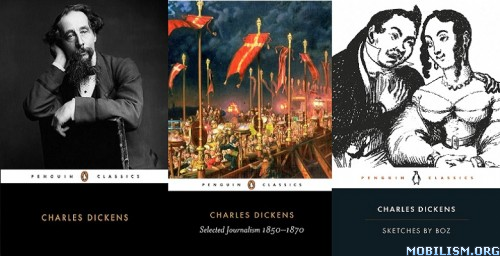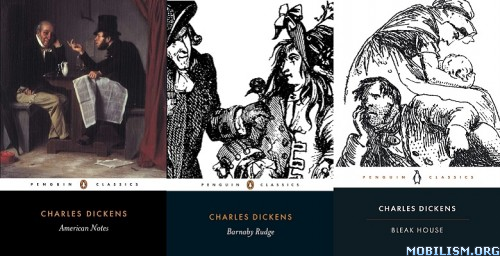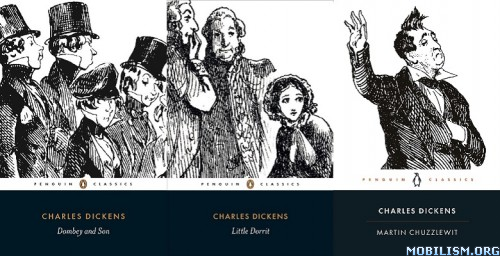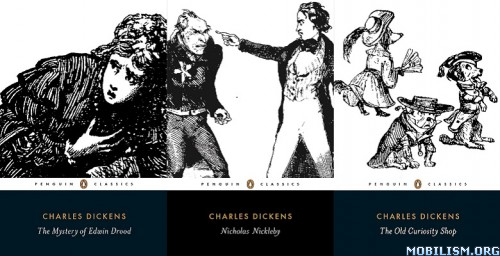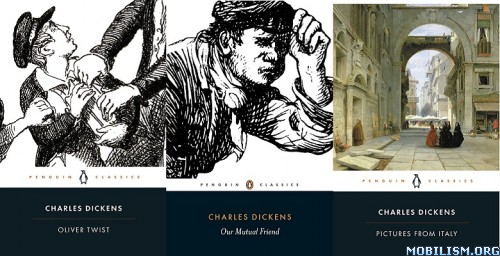15 Books (Penguin Classics Editions) by Charles Dickens
Requirements: .ePUB, .MOBI/AZW3, 278mb
Overview: Charles John Huffam Dickens FRSA was an English writer and social critic. He created some of the world’s best-known fictional characters and is regarded by many as the greatest novelist of the Victorian era.
Genre: General Fiction/Classics
American Notes (Penguin Classics)
by Charles Dickens, Patricia Ingham (Editor, Introduction)
When Charles Dickens set out for America in 1842, he was the most famous man of his day to make the journey, and embarked on his travels with an intense curiosity. His frank descriptions cover everything from his comically wretched sea voyage to his sheer astonishment at Niagara Falls, while he also visited hospitals, prisons and law courts. But Dickens’s depiction of America as a land ruled by money, built on slavery, with a corrupt press and unsavoury manners, provoked a hostile reaction on both sides of the Atlantic. American Notes is an illuminating account of a great writer’s revelatory encounter with the New World.
Barnaby Rudge (Penguin Classics)
by Charles Dickens, John Bowen (Editor, Introduction)
Charles Dickens’s Barnaby Rudge is a vivid portrait of London’s descent into anarchy, where ‘King Mob’ rules the streets, and innocent lives are swept up in the chaos. Set against the backdrop of the Gordon Riots of 1780, Barnaby Rudge is a story of mystery and suspense which begins with an unsolved double murder and goes on to involve conspiracy, blackmail, abduction and retribution. Through the course of the novel fathers and sons become opposed, apprentices plot against their masters and Protestants clash with Catholics on the streets. And, as London erupts into riot, Barnaby Rudge himself struggles to escape the curse of his own past. With its dramatic descriptions of public violence and private horror, its strange secrets and ghostly doublings, Barnaby Rudge is a powerful, disturbing blend of historical realism and Gothic melodrama. This edition is based on the one-volume publication of Barnaby Rudge, reproducing all the original illustrations by ‘Phiz’ and George Cattermole. Appendices include a map of London at the time of the Gordon Riots and the preface to the 1868 edition.
Bleak House (Penguin Classics)
by Charles Dickens, Nicola Bradbury (Editor, Introduction), Terry Eagleton (Preface)
As the interminable case of Jarndyce and Jarndyce grinds its way through the Court of Chancery, it draws together a disparate group of people: Ada Clare and Richard Carstone, whose inheritance is gradually being devoured by legal costs; Esther Summerson, a ward of court; the menacing lawyer Tulkinghorn; the determined sleuth Inspector Bucket; and even Jo, a destitute crossing-sweeper. A savage indictment of a society that is rotten to the core, Bleak House is one of Dickens’s most ambitious novels, with a range that extends from the drawing-rooms of the aristocracy to the London slums.
Dombey and Sons (Penguin Classics)
by Charles Dickens, Andrew Sanders (Editor)
A compelling depiction of a man imprisoned by his own pride, Dombey and Son explores the devastating effects of emotional deprivation on a dysfunctional family. Paul Dombey runs his household as he runs his business: coldly, calculatingly and commercially. The only person he cares for is his little son, while his motherless daughter Florence is merely a ‘base coin that couldn’t be invested’. As Dombey’s callousness extends to others, including his defiant second wife Edith, he sows the seeds of his own destruction.
Little Dorrit (Penguin Classics)
by Charles Dickens, Helen Small, Stephen Wall (Editor, Introduction)
When Arthur Clennam returns to England after many years abroad, he takes a kindly interest in Amy Dorrit, his mother’s seamstress, and in the affairs of Amy’s father, William Dorrit, a man of shabby grandeur, long imprisoned for debt in Marshalsea prison. As Arthur soon discovers, the dark shadow of the prison stretches far beyond its walls to affect the lives of many, from the kindly Mr Panks, the reluctant rent-collector of Bleeding Heart Yard, and the tipsily garrulous Flora Finching, to Merdle, an unscrupulous financier, and the bureaucratic Barnacles in the Circumlocution Office. A masterly evocation of the state and psychology of imprisonment, Little Dorrit is one of the supreme works of Dickens’s maturity. Stephen Wall’s introduction examines Dickens’s transformation of childhood memories of his father’s incarceration in the Marshalsea debtors’ prison. This revised edition includes expanded notes, appendices and suggestion for further reading by Helen Small, a chronology of Dickens’s life and works, and original illustrations.
Martin Chuzzlewit (Penguin Classics)
by Charles Dickens, Patricia Ingham (Editor, Introduction)
Greed has led wealthy old Martin Chuzzlewit to become suspicious and misanthropic, leaving his grandson and name-sake to make his own way in the world. And so young Martin sets out from the Wiltshire home of his supposed champion, the scheming architect Pecksniff, to seek his fortune in America. In depicting Martin’s journey Dickens created many vividly realized figures, from Martin’s optimistic manservant Mark Tapley to the drunken and corrupt private nurse Mrs Gamp. With its portrayal of greed, blackmail and murder, and its searing satire on America, Dickens’s novel is a powerful and blackly comic story of hypocrisy and redemption.
Mystery of Edwin Wood (Penguin Classics)
by Charles Dickens, David Paroissien (Editor)
Edwin Drood is contracted to marry orphan Rosa when he comes of age, but when they find that duty has gradually replaced affection, they agree to break off the engagement. Shortly afterwards, in the middle of a storm on Christmas Eve, Edwin disappears. Beyond this there are further intrigues: the dark opium underworld of the sleepy cathedral town of Cloisterham, and the sinister double life of choir-master Jasper, whose drug-fuelled fantasy life belies his appearance. Dickens died before completing Edwin Drood, leaving generations of readers to try and solve its tantalizing mystery.
Nicholas Nickleby (Penguin Classics)
by Charles Dickens, Mark Ford (Editor, Introduction), Hablot K. Browne "Phiz" (Illustrations)
The hero of Dickens’s flamboyantly exuberant novel, Nicholas Nickleby, is left penniless after his father’s death and forced to make his own way in the world. His adventures give Dickens the opportunity to portray an extraordinary gallery of rogues and eccentrics: Wackford Squeers, the tyrannical headmaster of Dotheboys Hall; the tragic orphan Smike, rescued by Nicholas; and the gloriously theatrical Mr and Mrs Crummle and their daughter, the ‘infant phenomenon’. Nicholas Nickleby is characterized by Dickens’s outrage at social injustice, but it also reveals his comic genius at its most unerring.
Old Curiosity Shop (Penguin Classics)
by Charles Dickens, Norman Page (Editor, Introduction, Notes), George Cattermole, Hablot K. Browne "Phiz" et.al. (Illustrations)
The sensational bestselling story of Little Nell, the beautiful child thrown into a shadowy, terrifying world, seems to belong less to the history of the Victorian novel than to folklore, fairy tale, or myth. The sorrows of Nell and her grandfather are offset by Dickens’s creation of a dazzling contemporary world inhabited by some of his most brilliantly drawn characters-the eloquent ne’er-do-well Dick Swiveller; the hungry maid known as the "Marchioness"; the mannish lawyer Sally Brass; Quilp’s brow-beaten mother-in-law; and Quilp himself, the lustful, vengeful dwarf, whose demonic energy makes a vivid counterpoint to Nell’s purity.
Oliver Twist (Penguin Classics)
by Charles Dickens, Philip Horne (Editor, Introduction, Notes)
The story of Oliver Twist – orphaned, and set upon by evil and adversity from his first breath – shocked readers when it was published. After running away from the workhouse and pompous beadle Mr Bumble, Oliver finds himself lured into a den of thieves peopled by vivid and memorable characters – the Artful Dodger, vicious burglar Bill Sikes, his dog Bull’s Eye, and prostitute Nancy, all watched over by cunning master-thief Fagin. Combining elements of Gothic Romance, the Newgate Novel and popular melodrama, Dickens created an entirely new kind of fiction, scathing in its indictment of a cruel society, and pervaded by an unforgettable sense of threat and mystery.
Our Mutual Friend (Penguin Classics)
by Charles Dickens, , Adrian Poole (Editor, Introduction, Notes)
Our Mutual Friend centres on an inheritance – Old Harmon’s profitable dust heaps – and its legatees: young John Harmon, presumed drowned when a body is pulled out of the Thames, and kindly dustman Mr Boffin, to whom the fortune defaults. With brilliant satire, Dickens portrays a dark, macabre London, inhabited by such disparate characters as Gaffer Hexam, scavenging the river for corpses; enchanting, mercenary Bella Wilfer; the social-climbing Veneerings; and the unscrupulous street-trader Silas Wegg. Dickens’s last completed novel is richly symbolic in its vision of death and renewal in a city dominated by the fetid Thames, and of the corrupting power of money.
Pictures from Italy (Penguin Classics)
by Charles Dickens, Kate Flint (Editor, Introduction, Notes)
In 1844, Charles Dickens took a break from novel writing to travel through Italy for almost a year, and Pictures from Italy is an illuminating account of his experiences there. He presents the country like a magic-lantern show, as vivid images ceaselessly appear before his – and his readers’ – eyes. Italy’s most famous sights are all to be found here – St Peter’s in Rome, Naples with Vesuvius smouldering in the background, the fairytale buildings and canals of Venice – but Dickens’s chronicle is not simply that of a tourist. Combining compelling travelogue with piercing social commentary, he portrays a nation of great contrasts: between grandiose buildings and squalid poverty, ancient monuments and everyday life, past and present.
Selected Journalism 1850-1870 (Penguin Classics)
by Charles Dickens, David Pascoe (Editor, Introduction)
Throughout his writing career Charles Dickens was a hugely prolific journalist. This volume of his later work is selected from pieces that he wrote after he founded the journal Household Words in 1850 up until his death in 1870. Here subjects as varied as his nocturnal walks around London slums, prisons, theatres and Inns of Court, journeys to the continent and his childhood in Kent and London are captured in remarkable pieces such as ‘Night Walks’, ‘On Strike’, ‘New Year’s Day’ and ‘Lying Awake’. Aiming to catch the imagination of a public besieged by hack journalism, these writings are an extraordinary blend of public and private, news and recollection, reality and fantastic description.
Selected Short Fiction (Penguin Classics)
by Charles Dickens, Deborah A. Thomas (Introduction), George Cattermole, Hablot K. Browne "Phiz" et.al. (Illustrations)
This witty and amusing collection of short pieces shows Dickens liberated from the more formal and sustained demands of the novel and experimenting with a diverse range of fictional techniques. In his tales of the supernatural, he creates frighteningly believable, spine-tingling stories of prophetic dreams and visions, as well as more fantastical adventures with goblins and apparitions. Impressionistic sketches combine imaginatively heightened travel journals with wry observations of home and abroad, while in his dramatic monologues, Dickens demonstrates his talent for exploring the secret workings of the human mind. These short works display Dickens’s exuberant sense of comedy and character as his imagination is given free rein.
Sketches by Boz (Penguin Classics)
by Charles Dickens, Dennis Walder (Editor, Introduction), George Cruikshank (Illustrator)
Charles Dickens’s first published book, Sketches by Boz is a funny and touching collection of observation, fancy and fiction showing the London he knew in all its complexity – its streets, theatres, inns, pawnshops, law courts, prisons and, of course, the river Thames. His descriptions of everyday life and people seem to anticipate characters from his great novels – garrulous matrons, vulgar young clerks, Scrooge-like bachelors – while his powers of social critique shine in his unflinching depictions of the city’s forgotten citizens, from child workers to prostitutes. This edition includes the original illustrations by George Cruikshank.
Download Instructions:
ALL Books:
https://ouo.io/F8RAlg
https://ouo.io/XggZPG
https://ouo.io/CA2hWD
American Notes
https://ouo.io/IxdhOFL
https://ouo.io/vn8t1u
Barnaby Rudge
https://ouo.io/kty218
https://ouo.io/nN131I
Bleak House
https://ouo.io/JsCqHK
https://ouo.io/m5oCOX1
Dombey and Sons
https://ouo.io/oH117Q
https://ouo.io/oMbq5v
Little Dorrit
https://ouo.io/Cgtdtd
https://ouo.io/o4RrWE5
Martin Chuzzlewit
https://ouo.io/5n8AUBL
https://ouo.io/kuAtX0n
Mystery of Edwin Wood
https://ouo.io/oeqjFCn
https://ouo.io/zSjfor
Nicholas Nickleby
https://ouo.io/2GBqndv
https://ouo.io/wVsVKiq
Old Curiosity Shop
https://ouo.io/pQM8zW
https://ouo.io/H6HAWW
Oliver Twist
https://ouo.io/JzmHnV
https://ouo.io/Jt8UvY
Our Mutual Friend
https://ouo.io/2Z8MJl
https://ouo.io/HrGnK2
Pictures from Italy
https://ouo.io/YNlFPx
https://ouo.io/mYRes5
Selected Journalism 1850-1870
https://ouo.io/SFNQlf6
https://ouo.io/WLRrP6
Selected Short Fiction
https://ouo.io/OCnkoo
https://ouo.io/HQ8uOTG
Sketches by Boz
https://ouo.io/BeVGzC
https://ouo.io/8M9EuD
